The Battle of the Four Courts, 28–30 June 1922
Published in Features, Issue 4 (July/August 2019), Volume 27What caused the ‘great explosion’?
By Michael Fewer
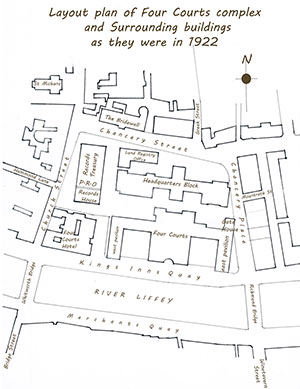
Fig. 1—The layout of the Four Courts complex as it was in June 1922. Most of the surrounding buildings, including the Four Courts Hotel, were occupied by the National Army during the siege. (Michael Fewer)
The Civil War began on 28 June 1922, when the National Army attacked an anti-Treaty force that had been in occupation of the Four Courts in Dublin since April of that year. After 60 hours of fighting and comparatively few casualties, the Four Courts garrison surrendered. Before the surrender, an enormous explosion (see front cover) occurred in the complex, after which most of the buildings, including the Treasury section of the Public Records Office, were destroyed by fire. Many of the accounts that I had read indicated that this explosion was caused by ‘a great mine’ or a store of explosives (two lorry loads of gelignite were mentioned by one historian, and four tonnes of explosives by another) being set off in the basement of the Public Records Office, scattering charred fragments of Ireland’s priceless historical records eastwards across the city of Dublin.
Free State propaganda
Contemporary Free State propaganda leaflets reported that the explosion was caused by a ‘connected mine’—in other words, a mine that had been deliberately electrically detonated in order to kill troops of the National Army who were in the process of taking the Four Courts.
A few years ago, while researching a biography of T.J. Byrne, chief architect of the Office of Public Works from 1923 to 1938, I found a paper that he delivered in 1928 about rebuilding the Four Courts. In it he referred to the ‘great explosion’ and the damage it, and the fires that had broken out in the complex, had caused. It was clear, to my surprise, that no explosion had occurred in the basement of the Public Records Office, and that the basement was in such good condition after the battle that it was the first part of the Four Courts complex to be put back into use again.
When I looked more closely into the matter, I was disturbed to find not only that important aspects of that ‘great explosion’ were often wrongly reported by historians but also that many other inaccurate or just plain untrue stories of crucial events that took place during the battle had become what Professor Tom Garvin dubbed ‘factoids’—that is, the accepted facts, ‘well-nigh impossible to eradicate from the historical record and the popular consciousness’. I found it hard to understand why the Battle of the Four Courts, surely one of the most important events in modern Irish history, was so poorly investigated by historians. The fighting during the first hours of the Civil War drew large crowds of spectators and was comprehensively recorded in newsprint, photographs and even newsreel film. In spite of this, it is clear that some historians who wrote about the fighting had little or no knowledge of the physical nature of the battleground, the buildings involved, or their external and internal layouts. No accurate analysis of the fighting that took place over those three fateful days in June 1922 could be carried out without a thorough knowledge of the battleground.
Layout
In 1922, as today, the Four Courts complex contained four distinct buildings that were occupied by the garrison: the Four Courts building along the quay, the Public Records Office on Church Street, the Land Registry Office along Chancery Street and the north block—what the garrison referred to as the ‘Headquarters Block’—extending from Chancery Place into the middle of the complex (Fig. 1). Dorothy McArdle betrayed her lack of understanding of the complex in her accounts of the fighting by referring to the Four Courts as ‘the building’. Recent publications, including the prestigious Atlas of the Irish Revolution, have maps showing the layout of the complex which fail to include one of the four buildings on the site, the Land Registry Office. Although the smallest of the buildings, it protected much of the north block, which the anti-Treaty garrison had made their headquarters and where they stockpiled their explosives, from observation and gunfire from the National Army-occupied Bridewell police station.
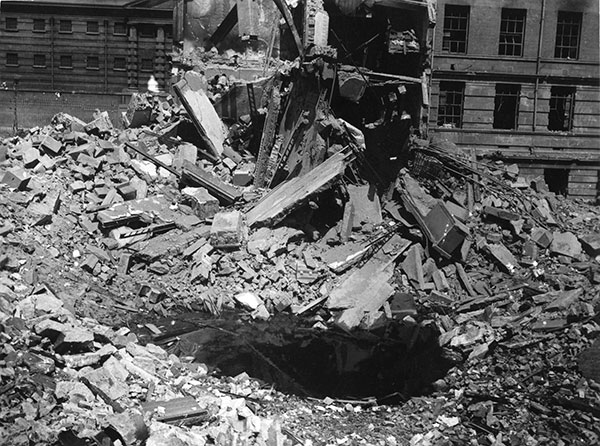
Fig. 2—Ground zero for the ‘great explosion’. At the far side of the crater are the destroyed walls, concrete floor and roof slabs of the south wing of the Land Registry Office. To the left, the Bridewell can be seen across Chancery Street. (Irish Architectural Archive)
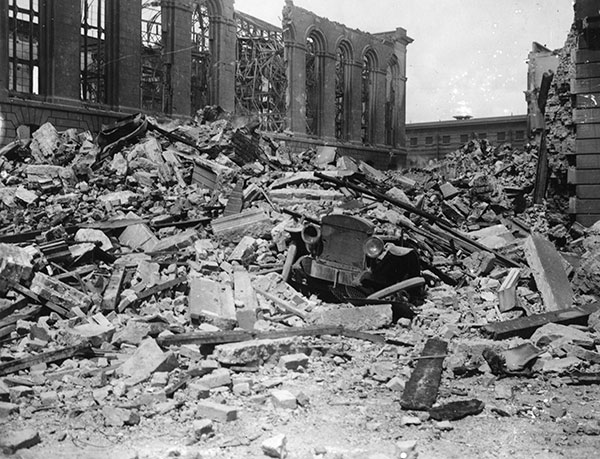
Fig. 3—The crater in Fig. 2 is just beyond the heap of rubble, behind the destroyed motor car. In the background is the Bridewell, and filling the left to centre is the eastern wall of the burnt-out Record Treasury. (Irish Architectural Archive)
Photographs held in the Irish Architectural Archive (Figs 2 and 3) confirm that, although the Public Records Office was damaged by the explosion, it did not occur there. Figure 2 shows ‘ground zero’ for the explosion: a great crater where the western end of the ‘headquarters block’ had stood, with the destroyed south wing of the Land Registry Office in the immediate background. Figure 3, taken about fifteen yards south of Fig. 2, shows, left and centre, the damaged eastern façade of the Public Records Treasury three days after fire had destroyed its priceless contents.
The Public Records Office had been captured and occupied by the National Army during the second day of the attack, and had been cleared of munitions. When the ‘great explosion’ occurred nearby on the following day, some of these troops were injured but no fatalities resulted. I found that even the newspapers of the day agreed that the explosion had happened in the ‘headquarters block’.
The ‘headquarters block’ (see Fig. 1) was a building that stood to the east of the Public Records Office and north of the well-known Four Courts block and ran the length of the courts. Built in the mid-nineteenth century, the building accommodated the Divorce and Probate Courts, offices for the Land Judges, the Incorporated Law Society’s offices and the headquarters of the Honourable the Benchers of King’s Inns. The anti-Treaty garrison established their store of explosive materials in the western end of this building, so that it would be near—but not too near—the factory that they had established in the Public Records Office for the manufacture of land mines and hand grenades. The ‘great explosion’ was caused by this store of materials blowing up. An Irish Times reporter wrote that ‘the papers that were scattered all over Dublin after the explosion dealt with Probate, Divorce or Land Judges matters, and would have been stored in the chambers near their respective courts …’.
Explosives were not detonated electrically
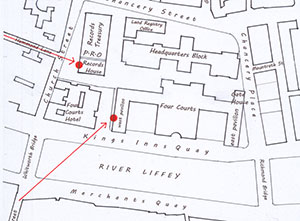
Fig. 5—The breaches to allow the National Army troops to enter the complex were made by one gun located at Bridge Street, south of the river, and another at the west end of Hammond Lane. The accuracy required by the gunners to punch the breaches in the walls without causing ‘collateral damage’ is clear in this plan. (Michael Fewer)
No record survives of the quantity of explosives stored in the headquarters block: various reports mention ‘thousands of sticks of gelignite’, ‘seven tons of munitions’ and ‘two tons of explosive material’. But if even the least of these was detonated electrically, the resulting supersonic shockwave would have completely destroyed buildings over a wide area and killed scores of combatants. There were, however, no fatalities. An examination of accounts of injuries and photographs of the actual damage that did occur suggests that the shockwave was probably subsonic, which indicates that the explosives were not detonated electrically but deflagrated—that is, they were set off by heat.
During the occupation a large collection of cars and lorries had been commandeered by the anti-Treaty forces and assembled there. The anti-Treaty IRA were intent on destabilising the new regime in Northern Ireland, and these vehicles were to provide transport for forces of Volunteers carrying out attacks on the north. It appears that some of the petrol for these vehicles was stored in the headquarters block. In addition, a number of accounts tell of barrels of paraffin also being stored in the headquarters block before the the siege, in preparation for setting fire to the building should the necessity arise.
A fire did break out in the building on the last morning of the siege, Friday 30 June, and it spread rapidly. It reached the store of explosive materials in the western end of the building at about 12.30pm, and when the temperature reached the critical level these materials deflagrated, causing the infamous ‘great explosion’. It showered the adjacent buildings, the main Four Courts block and the Records Treasury, with debris and burning embers, and fires soon broke out. Fire brigade members were ordered not to enter the Four Courts complex on account of exploding munitions, but no attempt was made to fight the fire in the Records Treasury, which could have been tackled safely from Church Street and Chancery Place (see Fig. 1). The fires raged for the rest of the day, driving the garrison to surrender, and at about 7pm the dome of the Four Courts collapsed.
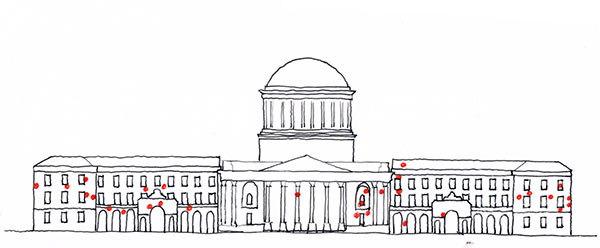
Fig. 4—Some of the early shell strikes on the south façades of the Four Courts. (Michael Fewer)
Competence of National Army gunners
Among many other matters that I found to have been poorly understood about the battle was what was regarded as the inability of the National Army men to competently operate the eighteen-pounder QF field guns that were used in the siege. I examined the challenges that these men faced, seeking the advice of a retired artillery officer on what was involved in the operation of these field pieces. After a thorough examination of contemporary photographs and accounts, I came to the conclusion that, with the little experience they had, these novice gunners did very well and carried out to the letter the orders they had been given.
At about 9.30pm on the evening before the siege began, two British Army QF eighteen-pounders and a supply of ammunition were handed over by the British Army, at the back gate of Marlboro Barracks, to Major-General Emmet Dalton of the National Army, an experienced soldier and a decorated veteran of the Great War. The eighteen-pounder was a versatile piece of light artillery that was still in service well into the Second World War. Among those with Dalton that evening was Commandant General Tony Lawlor; a few months before, Lawlor had been given command of the artillery barracks at Athlone and had begun training men to use an obsolete fifteen-pounder gun left behind by the British. Overseeing the hand-over of the guns on the British side was Major Colin Gubbins, later to make a name for himself as commander of the Special Operations Executive during the Second World War. The guns probably came with the 96-page manual, Gun drill for 18-pounder Q.F. gun (1920), which describes their operation and the duties of the gun crews. British army records indicate that the guns were signed over at ‘11.59 am’; it was more likely 11.59pm, and it seems reasonable to suggest that the period that elapsed between Dalton’s receiving the guns and the official signing-off left sufficient time for his men to receive basic instruction in their operation. Loading and firing was an uncomplicated procedure; in normal battlefield operations, where ranges of up to 6,000 yards were common, sighting arrangements for the guns were complex, but bombarding the Four Courts at such close range would be a much simpler matter.
Initial spread of shells
Once set up opposite the Four Courts, the initial task set for the gunners was to bombard the walls of the courts in the expectation that, when the garrison experienced the thunderous impact of shells, they would soon surrender. Apart from a couple of gaps, the two inexperienced gun crews succeeded in laying a competent spread of shells along every few metres of the south façades to make sure that everyone in the main building was fully aware of being under artillery fire (Fig. 4). Although there are records of a couple of men being shell-shocked, the garrison evacuated the areas that were coming under fire and many took shelter in the extensive basements.
When, after more than 24 hours, it became clear that this tactic was not going to force a surrender, a decision was made to attack the courts with infantry, and the gun crews were given new orders. Two substantial breaches were to be created to allow infantry access to the interior of the buildings, one in the west façade of the administrative offices of the Public Records Office and the other in the west façade of the west wing of the Four Courts (Fig. 5). The latter was no easy task for an inexperienced crew. They had a narrow ‘window’ in which to place their shells: they had to make sure to ‘miss’ a telegraph pole just across the road from where they were firing, and to avoid hitting the Four Courts Hotel, only metres away from the west wing, across Morgan Place, which was occupied by troops of the National Army. In both cases, the required breaches were made of sufficient size, in the right places and in a short space of time.
On the day after the siege ended, an Irish Independent correspondent praised the men operating the guns:
‘… it is a marvel, perhaps without precedent, that an artillery action went on, beginning on Wednesday morning about 4 o’clock, and continuing all through Wednesday, Thursday, and up to noon on Friday in the heart of the city … without doing any random damage to the persons or property of the citizens … when a large part of the Four Courts had been captured the artillery continued to work with precision and co-operation with the forces that had entered the positions—a feat, the difficulty of which can be realised by those who know the plan of the Four Courts.’
I believe that in my book I have managed to clarify a number of matters that have hitherto been either ignored or inaccurately reported, including the fact that the Public Records Office and its contents were not deliberately blown sky-high by a mine, and that those National Army novices operating the field guns performed very well indeed. Many questions still remain, however, about this first action of the Civil War; I hope that my attempt to throw some light on the matter will encourage historians to seek more answers.
Michael Fewer is the author of The Battle of the Four Courts: the first three days of the Irish Civil War (Head of Zeus, 2018).
FURTHER READING
D. O’Connor & F. Connolly (eds), Sleep soldier sleep (Dublin, 2011).
E. O’Malley, The singing flame (Cork, 2012).
















